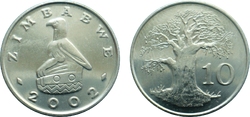- This article is about the Zimbabwean coin issued from 1980 to 2003. For the piece of Rhodesia, see Rhodesian 10 cent coin. For the 2014 bond coin, see Zimbabwean 10 cent coin (bond).
| 10 cents | |
|---|---|
| General information | |
| Country | |
| Value |
Z$0.10 |
| Years |
1980–2003 |
| Measurements and composition | |
| Mass |
3.8 g |
| Diameter |
20 mm |
| Thickness |
|
| Composition |
|
| Appearance | |
| Shape |
round |
| Alignment |
medallic |
| Edge |
plain |
| Obverse |
Zimbabwe Bird, state title, year |
| Reverse |
Baobab tree (Adansonia), value |
| v · d · e | |
The 10 cent coin is a former circulation piece of the Republic of Zimbabwe, issued in two varieties from 1980 to 2003. The first variety was introduced in 1980, shortly after the recognition of Zimbabwe's independence, and continued to be produced until 1999. It was followed by a similar coin in 2001, which only differed by its composition and measurements. This second variety was struck very briefly, until 2003.
Both pieces were distributed by the Reserve Bank of Zimbabwe (RBZ). The first was struck at the British Royal Mint in Llantrisant, Wales, and the second was produced at the Zimbabwe Mint in Bulawayo. Initially, the coins carried a legal tender face value of 0.10 Zimbabwean dollars, but after the redenomination of the dollar in 2005, they were eventually demonetized.
Pieces produced from 1980 to 1999 are composed of cupronickel and measure 1.5 millimeters in thickness, while those of later dates are made of a much cheaper alternative, nickel-plated steel, and measure a slightly larger 1.8 millimeters in thickness. In spite of these disparities, both varieties share a common mass of approximately 3.8 grams and a diameter of 20 millimeters. Regardless of variety, the 10 cent piece has medallic alignment and a plain edge, and like most coins, is round in shape. The rims of both the obverse and reverse are raised and undecorated.
Displayed in the middle of the obverse, designed by English artist Barry Stanton (1943–), is the Zimbabwe Bird. Such an illustration, as an official symbol of Zimbabwe, frequently appears on the nation's heraldry and official works, including its currency. Printed in a clockwise direction above the rendition, extending from the left to right rims, is the state title "ZIMBABWE". The Gregorian date of minting appears in the opposite direction below the Zimbabwe Bird. It is separated from the state title by two small diamond-shaped objects, with one at the lower left and one at the lower right boundaries of the obverse. The reverse, designed by Zimbabwean artist Jeff Huntly (–2008), features a baobab tree (Adansonia) in its center. Two species of such a plant – the African baobab (Adansonia digitata) and montane African baobab (Adansonia kilima) – are endemic to parts of Zimbabwe and neighboring countries. Printed to the right of the tree, next to the trunk under a lower branch, is the number "10", identifying a face value of 10 cents.
The total mintage of the 10 cent coin is currently unknown. Business strikes exist from all twelve years of production, along with 15,000 proofs from 1980 and 5,500 from 1997. The proofs were included exclusively in sets distributed by the government of Zimbabwe.
| Mintages | ||
|---|---|---|
| 1980 | Cupronickel | |
| 1980 Proof | 15,000 | |
| 1983 | ||
| 1987 | ||
| 1988 | ||
| 1989 | ||
| 1991 | ||
| 1994 | ||
| 1997 | ||
| 1997 Proof | 5,500 | |
| 1999 | ||
| 2001 | Nickel-plated steel | |
| 2002 | ||
| 2003 | ||
References
- Numismatic Guaranty Corporation – Zimbabwe 10 Cents KM# 3 (1980–1999) • Zimbabwe 10 Cents KM# 3a (2001–2003)
- Numista – 10 Cents - Zimbabwe (1980–1999) • 10 Cents - Zimbabwe (2001–2003) (English) (French)
- Numismatic Dimensions – Coins of Zimbabwe
- Reserve Bank of Zimbabwe – Mints
Zimbabwean dollar on the English Wikipedia
Template:Zimbabwean dollar


